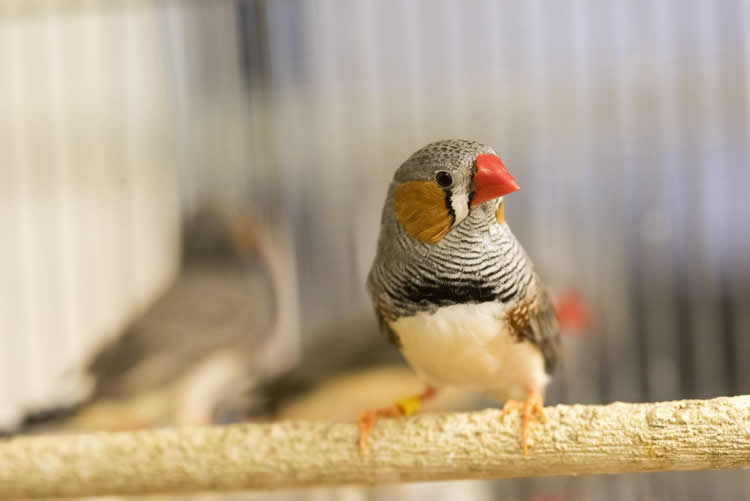Like humans, songbirds learn their vocalizations, suggesting they could be useful as models for certain disorders.
Many neurological disorders can rob someone of the ability to speak clearly, causing them to stutter, mispronounce words, and struggle to put together coherent sentences. However, the molecular and neurological dysfunctions that cause these symptoms aren’t well understood.
Recent work at The Rockefeller University may give researchers a new tool to better study these vocal and speech impairments, particularly in Huntington’s disease.
“There hasn’t been a good animal model for any kind of speech disorder,” says study author Wan-chun Liu, a senior research associate in Fernando Nottebohn’s Laboratory of Animal Behavior. “Rats and mice, the most common lab animals, can’t tell us much about speech disorders, since their vocalizations are innate, not learned. That’s what makes songbirds so special.” The research is described in a paper published on October 5 in Nature Neuroscience.
Like humans, songbirds and a few other types of birds can learn vocalizations. Liu used one such songbird, zebra finches, which are small, red-beaked birds common in pet stores, for the foundation of his research on neurodegeneration.
Liu’s experiments began by breeding finches with a singular genetic mutation–the introduction of mHTT, the mutant human gene responsible for Huntington’s disease. An inherited disorder that results in the progressive breakdown of nerve cells in the brain, Huntington’s leads people to lose control of their speech and movement, as well as to cognitive decline. Because Huntington’s is determined by a single gene, Liu was able to easily isolate its effects on the birds.
Liu’s team introduced the mHTT gene into eggs, then screened the chicks for the mutation once they hatched. The birds that had it were then used to breed successive generations, in whom the genetic mutation occurred naturally. That way the researchers could ensure that each bird developed the disease as it would manifest in humans.
As they grew, the transgenic finches all began to display the behavior disorders associated with Huntington’s, such as tremors sometimes seen in patients. Most of the mutant males, the singing sex, had problems learning their songs while young and, once fully grown, produced aberrant songs. Liu carefully selected the birds that appeared the most vocally impaired. “For example, some of the birds stuttered,” Liu says. “If the normal song was ‘ABCDE,’ these mutant birds could only sing ‘AAAA.'”
Using specialized computer software, Liu was able to monitor subtle changes in these finches’ song as their muscular degradation progressed, providing detailed records of how vocal patterns were affected. This kind of progressive speech impairment is associated with dysfunction in the cortical-basal ganglia brain circuit in both humans and songbirds, so Liu could make assumptions based on this trial about how the human brain circuit changes. His results are the clearest findings to date as to how this kind of neurodegeneration occurs.

His project builds upon a history of studies of song learning at Rockefeller. During more than two decades at Rockefeller, Peter Marler, a leader in the field, examined the interplay between the inborn program for song in young birds and the influence of social factors, uncovering parallels to speech acquisition in human babies. Meanwhile, Nottebohm studied the neural circuits responsible for song learning, including the cortical-basal ganglia pathways.
In recent years, songbirds’ similarities to human vocal learning have piqued researchers’ interests in using them as a functional animal model to study the neurological basis for Huntington’s disease.
It is difficult to overstate the potential value of such a tool in attempts to better understand, prevent, and treat this disorder, according to Liu. For the first time, scientists will be able to test out therapeutic treatments on vocal degeneration. “If we develop a drug, we can inject into a specific brain area and then trace moment by moment how it impacts the degradation of vocal ability in songbirds,” Liu says. “Our work has relevance beyond Huntington’s. By creating the first song bird models for vocal degeneration, we have achieved what I believe is a turning point for all kinds of diseases that affect speech, like Alzheimer’s, Parkinson’s, and autism.”
Source: Wynne Parry – Rockefeller University
Image Source: The image is credited to Zach Veilleux/The Rockefeller University
Original Research: Abstract for “Human mutant huntingtin disrupts vocal learning in transgenic songbirds” by Wan-chun Liu, Jessica Kohn, Sarah K Szwed, Eben Pariser, Sharon Sepe, Bhagwattie Haripal, Naoki Oshimori, Martin Marsala, Atsushi Miyanohara and Ramee Lee in Nature Neuroscience. Published online October 5 2015 doi:10.1038/nn.4133
Abstract
Human mutant huntingtin disrupts vocal learning in transgenic songbirds
Speech and vocal impairments characterize many neurological disorders. However, the neurogenetic mechanisms of these disorders are not well understood, and current animal models do not have the necessary circuitry to recapitulate vocal learning deficits. We developed germline transgenic songbirds, zebra finches (Taneiopygia guttata) expressing human mutant huntingtin (mHTT), a protein responsible for the progressive deterioration of motor and cognitive function in Huntington’s disease (HD). Although generally healthy, the mutant songbirds had severe vocal disorders, including poor vocal imitation, stuttering, and progressive syntax and syllable degradation. Their song abnormalities were associated with HD-related neuropathology and dysfunction of the cortical–basal ganglia (CBG) song circuit. These transgenics are, to the best of our knowledge, the first experimentally created, functional mutant songbirds. Their progressive and quantifiable vocal disorder, combined with circuit dysfunction in the CBG song system, offers a model for genetic manipulation and the development of therapeutic strategies for CBG-related vocal and motor disorders.
“Human mutant huntingtin disrupts vocal learning in transgenic songbirds” by Wan-chun Liu, Jessica Kohn, Sarah K Szwed, Eben Pariser, Sharon Sepe, Bhagwattie Haripal, Naoki Oshimori, Martin Marsala, Atsushi Miyanohara and Ramee Lee in Nature Neuroscience. Published online October 5 2015 doi:10.1038/nn.4133






